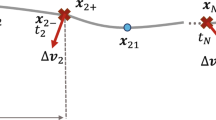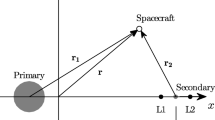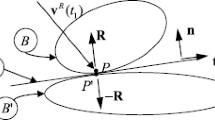Abstract
The paper deals with the problem of impulsive collision avoidance between two colliding objects in three dimensions and assuming elliptical Keplerian orbits. Closed-form analytical expressions are provided that accurately predict the relative dynamics of the two bodies in the encounter b-plane following an impulsive delta-V manoeuvre performed by one object at a given orbit location prior to the impact and with a generic three-dimensional orientation. After verifying the accuracy of the analytical expressions for different orbital eccentricities and encounter geometries the manoeuvre direction that maximises the miss distance is obtained numerically as a function of the arc length separation between the manoeuvre point and the predicted collision point. The provided formulas can be used for high-accuracy instantaneous estimation of the outcome of a generic impulsive collision avoidance manoeuvre and its optimisation.









Similar content being viewed by others
Notes
Although this condition is required for the present theoretical development, the analytical formulas here derived work also for the case of parallel velocities.
According to the present non-dimensionalisation that means the conjunction duration is small compared to the orbital period.
Typical collision avoidance manoeuvres involve velocity changes of the order of m/s, completely negligible when compared to their orbital velocity.
References
Akella, M., Alfriend, K.: Probability of collision between space objects. J. Guid. Control Dyn. 23(5), 769–772 (2000)
Alfano, S.: Aerospace support to space situational awareness. MIT Lincoln Laboratory Satellite Operations and Safety Workshop, Haystack Observatory, Chelmsford, Massachusetts (2002)
Alfano, S.: Collision avoidance maneuver planning tool. In: 15th AAS/AIAA Astrodynamics Specialist Conference, pp. 7–11 (2005)
Bombardelli, C, Baù, G.: Accurate analytical approximation of asteroid deflection with constant tangential thrust. Celest. Mech. Dyn. Astron. 114, 279–295 (2012)
Bombardelli, C., Bau, G., Pelaez, J.: Asymptotic solution for the two-body problem with constant tangential thrust acceleration. Celest. Mech. Dyn. Astron. 110(3), 239–256 (2011)
Chan, F.K.: Spacecraft Collision Probability. Aerospace Press, Beijing (2008)
Chan, K.: Collision probability analyses for earth-orbiting satellites. In: 2001 Flight Mechanics, Symposium, vol 1 (2001)
Conway, B.A.: Near-optimal deflection of earth-approaching asteroids. J. Guid. Control Dyn. 24(5), 1035–1037 (2001)
COPUOS: Towards long-term sustainability of space activities: overcoming the challenge of space debris. Tech. rep., a/AC.105/C.1/2011/CRP.14. Committee on the Peaceful Uses of Outer Space. Available on line at http://www.oosa.unvienna.org (2011-02-08)
Izzo, D.: Optimization of interplanetary trajectories for impulsive and continuous asteroid deflection. J. Guid. Control Dyn. 30(2), 401–408 (2007)
Kahle, R., Hahn, G., Kuhrt, E.: Optimal deflection of neos en route of collision with the earth. Icarus 182(2), 482–488 (2006)
Kim, E.H., Kim, H.D., Kim, H.J.: Optimal solution of collision avoidance maneuver with multiple space debris. J. Space Oper. 9(3), 19–31 (2012)
Krag, H., Flohrer, T., Lemmens, S.: Consideration of space debris mitigation requirements in the operation of LEO missions. Paper 1257086. In: Proceedings of the 12th International Conference on Space Operations, Stockholm, 11-15 June 2012, AIAA (2012)
Newman, K., Frigm, R., McKinley, D.: It’s not a big sky after all: justification for a close approach prediction and risk assessment process. Adv. Astronaut. Sci. 135(2), 1113–1132 (2009)
Patera, R.P.: General method for calculating satellite collision probability. J. Guid. Control Dyn. 24(4), 716–722 (2001)
Pelaez, J., Hedo, J., de Andres, P.: A special perturbation method in orbital dynamics. Celest. Mech. Dyn. Astron. 97(2), 131–150 (2007)
Righetti, P., Sancho, F., Lazaro, D., Damiano, A.: Handling of conjunction warnings in eumetsat flight dynamics. J. Aerosp. Eng. 3(2), 39 (2011)
Sanchez-Ortiz, N., Grande-Olalla, I., Pulido, J.A., Merz, K.: Collision risk assessment and avoidance manoeuvres—the new coram tool for esa. In: 64 th International Astronautical Congress, Beijing, China (2013)
Valsecchi, G., Milani, A., Gronchi, G., Chesley, S.: Resonant returns to close approaches: analytical theory. Astron. Astrophys. 408(3), 1179–1196 (2003)
Vasile, M., Colombo, C.: Optimal impact strategies for asteroid deflection. J. Guid. Control Dyn. 31(4), 858–872 (2008)
Yamanaka, K., Ankersen, F.: New state transition matrix for relative motion on an arbitrary elliptical orbit. J. Guid. Control Dyn. 25(1), 60–66 (2002)
Acknowledgments
The study has been supported by the research project “Dynamic Simulation of Complex Space Systems” supported by the Dirección General de Investigación of the (no longer existing) Spanish Ministry of Science and Innovation through contract AYA2010-18796. The author would like to thank the two reviewers as well as Noelia Sánchez-Ortiz (Deimos Space) and Pierluigi Righetti (Eumetsat) for their useful suggestions.
Author information
Authors and Affiliations
Corresponding author
Rights and permissions
About this article
Cite this article
Bombardelli, C. Analytical formulation of impulsive collision avoidance dynamics. Celest Mech Dyn Astr 118, 99–114 (2014). https://doi.org/10.1007/s10569-013-9526-3
Received:
Revised:
Accepted:
Published:
Issue Date:
DOI: https://doi.org/10.1007/s10569-013-9526-3




